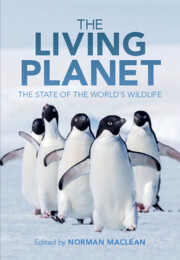Book contents
- The Living Planet
- The Living Planet
- Copyright page
- Contents
- Contributors
- Preface
- Acknowledgements
- One Introduction and the Evolution of Life on Earth
- Two Flowering Plants
- Three Bryophytes and Pteridophytes: Spore-Bearing Land Plants
- Four Terrestrial Mammals
- Five Marine Mammals: Exploited for Millennia, But Still Holding On
- Six How Birds Reveal the Scale of the Biodiversity Crisis
- Seven Reptiles
- Eight Amphibians
- Nine Freshwater Fishes: Threatened Species and Threatened Waters on a Global Scale
- Ten The Amazing Yet Threatened World of Marine Fishes
- Eleven Insects
- Twelve Marine Invertebrates
- Thirteen Non-Insect Terrestrial Arthropods
- Fourteen Terrestrial Invertebrates Other Than Arthropods and Molluscs
- Fifteen Non-Marine Molluscs
- Sixteen An Account of the Diversity and Conservation of Fungi and Their Close Relatives
- Seventeen Simple Life Forms
- Eighteen Assessing Species Conservation Status: The IUCN Red List and Green Status of Species
- Nineteen Problems with the World’s Ecosystems: The Future and Attempts to Mitigate Decline
- Twenty Conservation Methods and Successes
- Twenty One What Does the Future Hold for Our Planet and its Wildlife?
- Species Index
- Subject Index
- References
Ten - The Amazing Yet Threatened World of Marine Fishes
Published online by Cambridge University Press: 13 April 2023
- The Living Planet
- The Living Planet
- Copyright page
- Contents
- Contributors
- Preface
- Acknowledgements
- One Introduction and the Evolution of Life on Earth
- Two Flowering Plants
- Three Bryophytes and Pteridophytes: Spore-Bearing Land Plants
- Four Terrestrial Mammals
- Five Marine Mammals: Exploited for Millennia, But Still Holding On
- Six How Birds Reveal the Scale of the Biodiversity Crisis
- Seven Reptiles
- Eight Amphibians
- Nine Freshwater Fishes: Threatened Species and Threatened Waters on a Global Scale
- Ten The Amazing Yet Threatened World of Marine Fishes
- Eleven Insects
- Twelve Marine Invertebrates
- Thirteen Non-Insect Terrestrial Arthropods
- Fourteen Terrestrial Invertebrates Other Than Arthropods and Molluscs
- Fifteen Non-Marine Molluscs
- Sixteen An Account of the Diversity and Conservation of Fungi and Their Close Relatives
- Seventeen Simple Life Forms
- Eighteen Assessing Species Conservation Status: The IUCN Red List and Green Status of Species
- Nineteen Problems with the World’s Ecosystems: The Future and Attempts to Mitigate Decline
- Twenty Conservation Methods and Successes
- Twenty One What Does the Future Hold for Our Planet and its Wildlife?
- Species Index
- Subject Index
- References
Summary
Fishes are the original and most diverse group of vertebrates, including over 35,000 of the estimated 69,000 species with backbones. Most marine fishes have large geographic ranges that may provide some protection from extinction, but there are very important exceptions
Keywords
- Type
- Chapter
- Information
- The Living PlanetThe State of the World's Wildlife, pp. 206 - 226Publisher: Cambridge University PressPrint publication year: 2023

